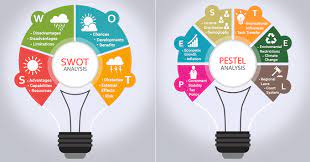What are SWOT and PESTLE audits?
Before you start building your subscriber list or sending emails, you will need to do some analyses to ensure your email marketing strategies are thoughtful, effective, and add value for your subscribers. SWOT and PESTLE can help you create a successful email marketing campaign.
- A SWOT audit identifies a company’s strengths, weaknesses, opportunities, and threats.
- A PESTLE audit identifies political, economic, social, technological, legal, and environmental factors that may affect your email marketing strategy.
You’ll want to conduct these audits before you craft your campaign, but it’s also a good idea to repeat these audits throughout the duration of your campaigns as well. You may want to conduct audits with team members to ensure nothing is left out. Start with a sheet of paper, a digital document like a Google Doc, or a whiteboard. Using header text, create a clear separation between each section so that your document or notes are very clear.
SWOT
As you start your audit, go through each part of the acronym and answer questions like:
- Strengths:
- What aspects of the company’s marketing resources make it stand out?
- What is special about the marketing team? (examples: eye–catching design, innovative ideas, strong copywriting)
- What things does your company excel at internally?
- Weaknesses:
- Where could your company and/or marketing team improve?
- What aspects of your brand have you been neglecting?
- What could you spend more time prioritizing?
- What types of training are required to complete necessary tasks?
- Where are you underperforming?
- Opportunities:
- What resources, events, or contacts, would help your team create a successful campaign?
- What types of opportunities can you leverage to improve your process or results?
- Threats:
- What events, contacts, and opportunities could be harmful to your brand?
- Do you have competitors?
- Do you have the resources necessary to complete tasks?
After you’ve conducted your SWOT analysis, reflect on the results. What are your general thoughts or trends you identify in the results? What did you learn about your company? How can you use this information to create an effective campaign?
PESTLE
Following your SWOT analysis, focus on the external factors by conducting a PESTLE audit. Like you did with SWOT, conduct your audit with a team in a collaborative setting like in a shared note, Google document, a dry erase board, or something else that works best for your team. As you work your way through each part of the audit, ask yourself the following questions, as well as anything else that feels important to your company.
- Political:
- Have there been any recent changes in terms of governing bodies?
- Is there political unrest in a country you just started shipping to?
- Is there any new legislation that could impact your business?
- Economic:
- What is the current state of the local and international economies in areas that you serve?
- What do people in various geographic locations prioritize spending money on?
- Social:
- What popular culture events have taken place in the locations you serve?
- What are the education levels of potential customers?
- What are the traditions and cultural norms of the people you serve?
- How do people interact with one another in the regions you serve?
- Technological
- How is technology changing the way people consume?
- How is technology changing the way people interact?
- How has technology changed in the last 6 months? 1 year?
- Legal
- What are the regulations and laws in the regions your company serves?
- How do the laws and regulations differ across regions?
- Environmental
- What does it mean to be a sustainable company?
- How important is climate change to your potential customers?
- Have there been recent natural disasters in regions you might serve?
Just as you reflected on the results of your SWOT audit, do the same for your PESTLE audit. When you’ve captured results from your SWOT and PESTLE audits, you can use them to create thoughtful, smart campaign strategies. The more research and brainstorming you do before the campaign, the more information you’ll have available to create a successful campaign.
